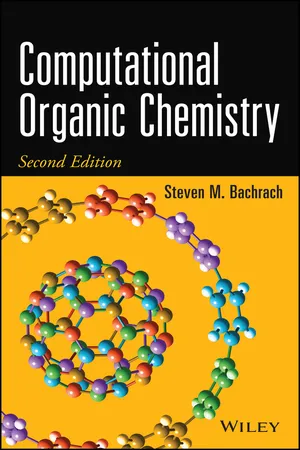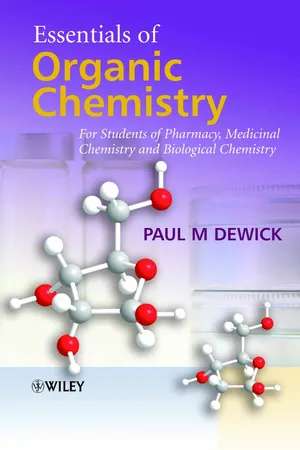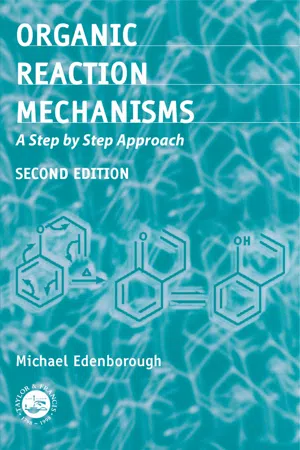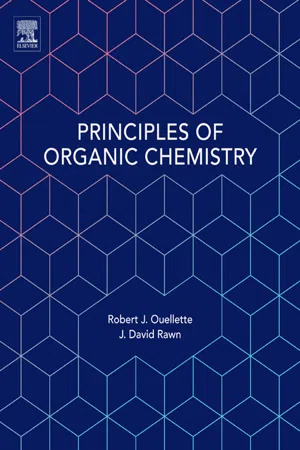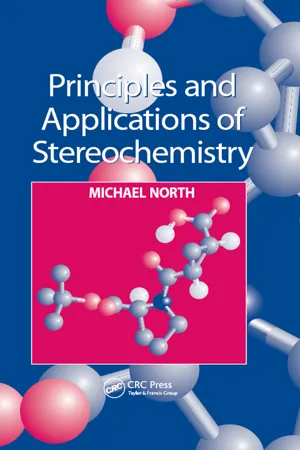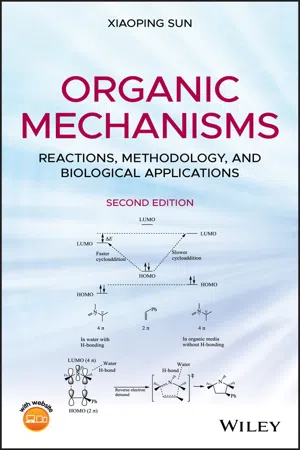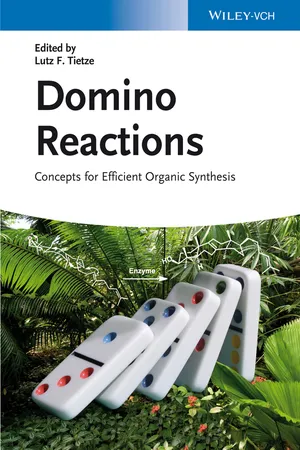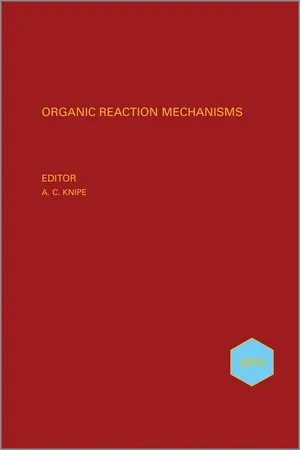Chemistry
SN2 Reaction
The SN2 (substitution nucleophilic bimolecular) reaction is a type of nucleophilic substitution reaction in organic chemistry. It involves a nucleophile attacking the substrate molecule, leading to the displacement of a leaving group. The reaction occurs in a single step, with the nucleophile and the leaving group involved in the rate-determining step.
Written by Perlego with AI-assistance
Related key terms
Related key terms
1 of 4
Related key terms
1 of 3
8 Key excerpts on "SN2 Reaction"
- eBook - ePub
- Steven M. Bachrach(Author)
- 2014(Publication Date)
- Wiley(Publisher)
N 2 reaction, with emphasis on the gas versus solution phase, is presented first. Next, we describe the critical contribution that computational chemists made in developing the theory of asymmetric induction at carbonyl and vinyl compounds. The chapter concludes with a discussion on the collaborative efforts of synthetic and computational chemists in developing organic catalysts, especially proline and proline-related molecules, for the aldol, Mannich and Michael reaction, and other related reactions.6.1 Substitution Reactions
Nucleophilic substitution reactions are among the first synthetic transformations introduced to beginners learning organic chemistry. The mechanisms for these reactions—SN 1 and SN 2—provide the paradigm for mechanistic understanding of organic reactions. The level of detailed understanding of how nucleophilic substitution occurs in solution is unprecedented, providing the ability to predict regioselectivity and stereoselectivity and relative rates and solvent effects with great accuracy.Most quantum chemical calculations model the gas phase. The SN 1 reaction is essentially unknown in the gas phase. The first step of this mechanism is the heterolytic cleavage of the C–X bond, forming a carbocation and an anionic leaving group. In the gas phase, this separation is strongly opposed by the electrostatic attraction of these two ions, creating a very large barrier. Therefore, this chapter focuses on the SN 2 reaction: the nature of its potential energy surface (PES), the effect of α- and β-branching, and a brief survey of approaches taken toward incorporating solvent into the calculation.6.1.1 The Gas Phase SN 2 Reaction
The mechanism for the gas phase SN 2 reaction is well understood. The extensive experimental studies by Brauman provide the general PES shown in Figure 6.1 .1, 2 The nucleophile and substrate first come together purely by electrostatic attraction to form the entrance ion–dipole complex (ID1). Next, the nucleophile approaches the carbon atom from the backside, pushing out the leaving group, through the classic SN 2 transition state (TS). As the leaving group exits, the exit ion–dipole complex (ID2 - eBook - ePub
Essentials of Organic Chemistry
For Students of Pharmacy, Medicinal Chemistry and Biological Chemistry
- Paul M. Dewick(Author)
- 2013(Publication Date)
- Wiley(Publisher)
6
Nucleophilic reactions: nucleophilic substitution
As the term suggests, a substitution reaction is one in which one group is substituted for another. For nucleophilic substitution, the reagent is a suitable nucleophile and it displaces a leaving group. As we study the reactions further, we shall see that mechanistically related competing reactions, eliminations and rearrangements, also need to be considered.6.1 The SN 2 reaction: bimolecular nucleophilic substitution
The abbreviation SN 2 conveys the information ‘substitution–nucleophilic–bimolecular’. The reaction is essentially the displacement of one group, a leaving group, by another group, a nucleophile. It is a bimolecular reaction, since kinetic data indicate that two species are involved in the rate-determining step:where Nu is the nucleophile, RL the substrate containing the leaving group L, and k is the rate constant.In general terms, the reaction can be represented as belowDifferences in electronegativities (see Section 2.7) between carbon and the leaving group atom lead to bond polarity. This confers a partial positive charge on the carbon and facilitates attack of the nucleophile. As the nucleophile electrons are used to make a new bond to the carbon, electrons must be transferred away to a suitable acceptor in order to maintain carbon’s octet. The suitable acceptor is the electronegative leaving group.The nucleophile attacks from the side opposite the leaving group – electrostatic repulsion prevents attack in the region of the leaving group. This results in an inversion process for the other groups on the carbon centre under attack, rather like an umbrella turning inside out in a violent gust of wind. The process is concerted, i.e. the bond to the incoming nucleophile is made at the same time as the bond to the leaving group is being broken. As a consequence, the mechanism involves a high-energy transition state in which both nucleophile and leaving group are partially bonded, the Nu–C–L bonding is linear, and the three groups X, Y, and Z around carbon are in a planar array. This is the natural arrangement to minimize steric interactions if we wish to position five groups around an atom, and will involve three sp 2 orbitals and a p orbital as shown. The p orbital is used for the partial bonding; note that we cannot have five full bonds to a carbon atom. The energy profile for the reaction (Figure 6.1 - eBook - ePub
Organic Reaction Mechanisms
A Step by Step Approach, Second Edition
- Michael Edenborough(Author)
- 2017(Publication Date)
- CRC Press(Publisher)
SN 2. In this case, the rate of the reaction is observed to be dependent upon both the concentration of the species being substituted, i.e. the substrate, and also upon the incoming nucleophile. The reaction, therefore, is a second order reaction; that is, the sum of the indices of the concentration of the reagents in the rate equation equals two. The order of a reaction is an experimentally observed number and need not be an integer.The mechanism for the SN 2 reaction occurs in only one step, in contrast to the two steps involved in the SN 1 reaction. The incoming nucleophile arrives at the same time as the leaving group departs, i.e. there is simultaneous bond cleavage and bond formation. Any reaction step that involves two molecules is said to have a molecularity of two. The molecularity is a theoretical concept and depends upon the details of the mechanistic step being proposed. By its very nature, it must be a whole number as it represents the number of molecules involved in that step.The rate of an SN 2 reaction may be affected by many different factors, which are similar to those that affect the rate of an SN 1 reaction. These points may be illustrated by examining in detail the approach and simultaneous departure of the incoming nucleophile and leaving group respectively.First, draw a diagram to illustrate the initial approach of a nucleophile, Nuc−, to a general substrate, R3 CX, where X− will eventually become the leaving group. Consider the direction from which the incoming nucleophile will approach.It seems reasonable to suppose that the incoming nucleophile will approach the substrate from a direction that is the opposite to the one in which the C–X bond is to be broken. Thus, the attack is from the opposite side to that from which the leaving group will eventually depart. This ensures that the incoming nucleophile does not interfere with the subsequent departure of the leaving group as the anion, X– - eBook - ePub
- Robert J. Ouellette, J. David Rawn(Authors)
- 2015(Publication Date)
- Elsevier(Publisher)
N 1 mechanism.Figure 7.4 Stereochemical Effects in SN 1 ReactionsA chiral starting material, (S)-3-methyl-3-bromohexane, reacts with water to give a tertiary carbocation. This intermediate is planar and can be attacked by water either from the top or bottom side to give a racemic mixture of products. The reaction proceeds by an SN 1 mechanism.7.5 SN 2 Versus SN 1 Reactions
Now that we have outlined the general properties of SN 2 and SN 1 reactions, let’s see if we can predict which one is likely to occur. We will consider (1) the structure of the substrate, (2) the nucleophile, and (3) the nature of the solvent.Structure of the Substrate
Primary haloalkanes almost always react in nucleophilic substitution reactions by the SN 2 mechanism, whereas tertiary haloalkanes react by the SN 1 mechanism. Secondary haloalkanes may react by either mechanism depending on the nature of the nucleophile and the solvent.Effect of the Nucleophile
The nature of the nucleophile sometimes determines the mechanism of a nucleophilic substitution reaction. If the nucleophile is a highly polarizable species such as thiolate ion, RS− , it tends to react by an SN 2 mechanism. If the nucleophile is an uncharged species such as H2 O or CH3 OH, an SN 1 mechanism is more likely.Effect of the Solvent
Until now, we have neglected the role of solvent in nucleophilic substitution reactions, but the choice of solvent can tip the balance in favor of a particular substitution mechanism. We have seen that secondary haloalkanes can react by either an SN 1 or an SN 2 mechanism. In these cases, the polarity of the solvent plays an important role. The SN 1 process forms a carbocation intermediate. A polar solvent stabilizes charged species better than a nonpolar solvent, therefore it increases the rate of SN 1 reactions much more than it affects the rate of SN - eBook - ePub
- Michael North(Author)
- 2017(Publication Date)
- Routledge(Publisher)
molecularity of the reaction, that is the number of molecules which are involved in the rate limiting step of the reaction. The two mechanisms have different stereochemical consequences and each will be discussed in turn.9.2.1 SN 2 reactionsIn an SN 2 reaction, the nucleophile and the electrophile (the species containing the leaving group) are both involved in the rate limiting (and only) step of the mechanism as shown in Scheme 9.2 , giving a bimolecular reaction. Thus the nucleophile (Y_ ) ‘attacks’ the carbon bearing the leaving group (X) at an angle of 180° to the C–X bond, to give in a single step the product via a trigonal bipyramidal transition state. A number of reasons have been proposed to account for the fact that the nucleophile approaches at 180° to the C–X bond. This trajectory minimizes both steric and electronic repulsions between the nucleophile and the four substituents already attached to the carbon atom. Probably more importantly, however, the unoccupied C–X σ* orbital is orientated in this direction as shown in structure9.1.Scheme 9.2During the substitution reaction, an electron pair is donated by the nucleophile to the electrophile as represented by the curly arrow in Scheme 9.2 . These electrons can only be donated into an unoccupied molecular orbital and for energetic reasons this will be the Lowest energy Unoccupied Molecular Orbital (LUMO) which is the σ* orbital of the C–X bond. Similarly for energetic reasons, the electrons will be donated from the Highest energy Occupied Molecular Orbital (HOMO) of the nucleophile. Thus for reaction to occur there must be an interaction between the HOMO of the nucleophile and the LUMO of the electrophile, and it is this that determines the trajectory along which the nucleophile approaches the C–X bond. The orientations and relative energies of the HOMO and LUMOs of chemical species determine the nature of the reactions they undergo. These two orbitals are collectively referred to as frontier orbitals. In both Scheme 9.1 and Scheme 9.2 , the nucleophile has been shown as being negatively charged; this is not necessarily the case, since many neutral species which contain lone pairs of electrons or electrons held in p - eBook - ePub
Organic Mechanisms
Reactions, Methodology, and Biological Applications
- Xiaoping Sun(Author)
- 2020(Publication Date)
- Wiley(Publisher)
This steric hindrance (characteristic of a tertiary‐butyl group or any tertiary substrate) makes an S N 2 reaction extremely slow (Fig. 6.5). On the other hand, because a tertiary carbocation, such as (CH 3) 3 C +, is relatively stabilized, an S N 1 reaction for a tertiary substrate can take place in a relatively fast rate (Fig. 6.17). In general, the nucleophilic substitution reaction of a tertiary (3°) substrate always follows the S N 1 mechanism. The reaction can be effected by a weak nucleophile (mostly neutral molecules). The type of solvents can change the reaction rate, but does not change the mechanism. For a secondary (2°) substrate such as 2‐halopropane (CH 3) 2 CHX, as the number of methyl groups on the central electrophilic carbon increases, the steric hindrance to the nucleophilic attack from the opposite side of the leaving group is getting more severe. This disfavors an S N 2 reaction, but does not completely prevent it from happening (Fig. 6.5). On the other hand, the stability of a secondary (2°) carbocation allows the S N 1 reaction of a 2° substrate to take place in an appreciable rate (see Fig. 6.17). In addition, a primary substrate which contains an unsaturated group (such as phenyl and vinyl) on the electrophilic carbon can also have both S N 1 and S N 2 reactions. In general, the nucleophilic substitution reactions of a secondary (2°) substrate and a primary (1°) benzylic or allylic substrate can follow either the S N 2 or S N 1 mechanism, depending on the nature of the nucleophile and solvent. Usually, when a reaction is performed with a strong nucleophile (mostly, an anion) in an aprotic solvent, it follows the S N 2 mechanism. If a reaction is performed with a weak nucleophile (mostly, a neutral molecule) in a protic solvent, it follows the S N 1 mechanism. Now, let us look at nucleophilic substitution reactions of (R)‐2‐bromobutane, a secondary haloalkane, performed in different conditions (Fig - eBook - ePub
Domino Reactions
Concepts for Efficient Organic Synthesis
- Lutz F. Tietze(Author)
- 2013(Publication Date)
- Wiley-VCH(Publisher)
N 1 reaction) [1b]. The primary step in this process is the attack of a nucleophilic species, either an anion (e.g., a carbanion, an enolate, alkoxide, or thiolate) or a “pseudo” anion, as an uncharged nucleophile (e.g., an amine or an alcohol) on to an electrophilic center bearing a leaving group. A bond formation takes place with the creation of a new “real” or “pseudo-anionic” functionality, which can undergo further transformations, by being trapped by an electrophilic center present in the molecule (conjugated enone, aldehyde, epoxide, etc.). The sequence can then be terminated either by the addition of a proton or by the elimination of an X group.In the first part of the chapter, we have covered mostly those reactions, initiated by SN 2 type nucleophilic substitution, followed by a Michael reaction on a α,β-unsaturated ketone moiety, present in the intermediate adduct (SN /Michael). A few examples of the reactions with carbonyl compounds and alkyl halides (twofold SN reactions) in the second step are also included.The large numbers of domino reactions, which are initiated by nucleophilic substitution, are those, involving nucleophilic ring opening of three membered rings, for example, epoxides, aziridines, and a few activated cyclopropanes. These strained three membered compounds undergo facile ring opening by various nucleophiles, resulting in the generation of another nucleophilic species (e.g., alkoxide or amine), which can react further inter- or intramolecularly, undergoing a variety of reactions, including transition metal catalyzed cross-coupling reactions. In this context, it should be noted that it is of no relevance, whether the process involves a nucleophilic or electrophilic ring opening of an epoxide or aziridine and whether a carbocationic intermediate is of formal or real nature. Thus, the second part of the chapter deals with those domino reactions involving nucleophilic ring opening of epoxides, aziridines, and cyclopropyl ketones as the first step.The third section of the chapter describes recently developed “anion relay chemistry” (ARC) involving threefold domino SN -Brook rearrangement/SN - eBook - ePub
Organic Reaction Mechanisms 2010
An annual survey covering the literature dated January to December 2010
- A. C. Knipe(Author)
- 2012(Publication Date)
- Wiley(Publisher)
It is suggested that the S N 2 reaction at nitrogen does not occur because the approach of the nucleophile to the acidic hydrogen on carbon is more energetically favoured than the approach to nitrogen. NH 2 − is predicted to react with methyl and ethyl nitrates similar to OH −. Only the S N 2 reaction is found when the nucleophile is SH −. Studies of the S N 2/E2 reactions between methyl, ethyl, i -propyl and t -butyl iodide and cyanide ion 62 and between methyl iodide and fluoride ion 90 in the gas phase are discussed above. Miscellaneous Kinetic and Product Studies The S N reactions of propargylic alcohols and their derivatives catalysed by transition metals, transition metal Lewis acids that proceed via propargylic carbenium ion intermediates, or Brønsted acid organocatalysts have been reviewed. 112 Sulfonation of the N -Boc derivatives of 1-aryl-2-amino-1-ols to give the 2-amino-1-arylsulfonates is the slow step in a sequence of reactions forming 1,3-oxazolidin-2-ones. 109 The reactions occur with inversion of configuration when the erythro stereoisomer (32) reacts but with both retention and inversion of configuration when the threo stereoisomer (33) reacts. Experiments where iodide ion was added to the reaction mixture, and B3LYP/6-31G** calculations on a model system using PCM theory to account for the solvent, suggest that cyclization of the erthyro stereoisomer (32) occurs by S N 2 reaction, whereas the threo stereoisomer (33) reacts by both S N 2 and a double substitution mechanisms (S N 2– S N 2) (Scheme 8). Scheme 8 The aryl(sulfonyl)amino leaving group that can be prepared from amines via arylamines or sulfonylamines has been used in intramolecular S N reactions forming five- or six-membered ring cyclic compounds in moderate to high yields (59–99%) and with complete inversion of configuration. 113 The internal nucleophiles can be nitrogen-, oxygen-, or even carbon. Products are azacycles, cyclic ethers or lactones, and carbocycles
Index pages curate the most relevant extracts from our library of academic textbooks. They’ve been created using an in-house natural language model (NLM), each adding context and meaning to key research topics.
Explore more topic indexes
Explore more topic indexes
1 of 6
Explore more topic indexes
1 of 4
